
Visit Shrines
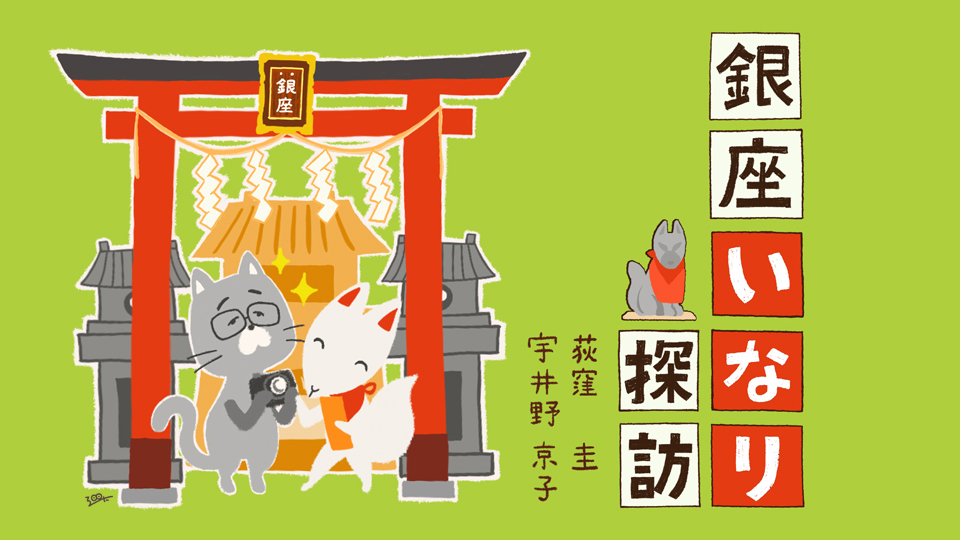
Visit Ginza’s Inari Shrines Vol.6 Kabuki Inari
2021.05.01
The Kabukiza Theatre is one of Japan’s leading theaters that show kabuki performances every month. It has been refurbished into a building with modern facilities but its historical image remains in the façade featuring its bargeboard. The Kabuki Inari is located in the Kabukiza Theatre.
This time our guides met in front of the reconstructed Kabukiza, completed in Heisei 25 (2013).

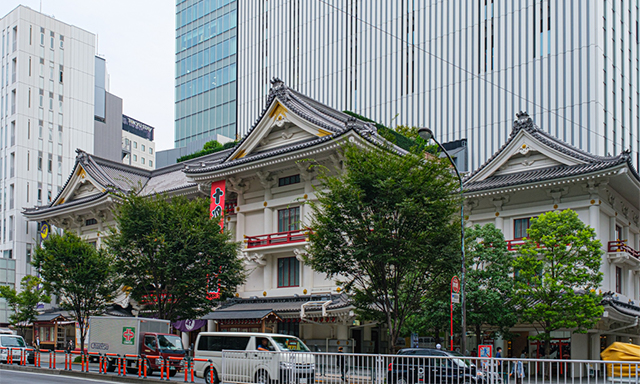
- Uino
- Ogikubo-san, have you ever seen a kabuki performance at the Kabikiza?
- Ogikubo
- Just once, a long time ago. It must have been twenty years ago. I came with a friend and indulged in watching kabuki all day. It was before the theater was refurbished. I have not been seen any acts after its renewal.
- Uino
- Did you notice the Inari shrine on your last visit?
- Ogikubo
- There is an Inari shrine here? I must have missed it.
- Uino
- Yes there is! Back then, it could only be accessed from inside the theater, through the back door.
- Ogikubo
- So, you had to see a performance to visit the shrine.
- Uino
- In fact, it would go unnoticed even by those who came into the theater for a performance. You could have a glimpse of it from the outside, and walking down the street on the side of the Kabukiza, I would occasionally see people praying toward it. They were mostly stage carpenters and other people from the performance. I always had the impression that it was a mysterious shrine.
- Ogikubo
- That’s why I missed it when I saw the kabuki performance. It is no surprise that a theater as large the Kabukiza would have an Inari shrine inside. I can imagine prayers being offered for a successful run through the final day being offered every time a new program comes on.
- Uino
- Yes, Oinari-sama (the Inari deity) is also a god of the performing arts.
- Ogikubo
- By the way, did you just say, “back then?”
- Uino
- Yes, I did. So…
- Ogikubo
- So, does that mean that we can visit it without going into the theater now?
- Uino
- That’s right. It still stands on the premises of the theater, but it has been moved outside. You may not have noticed it because you came on foot, but if you had used the subway you might have noticed it. It can be found of the ground floor, if you walk through the underground passage from Higashi Ginza Station, across Kobikicho Hiroba, just below the Kabukiza, and come up on the escalator.
- Ogikubo
- Let me imagine myself coming up the escalator from Kobikicho Place.
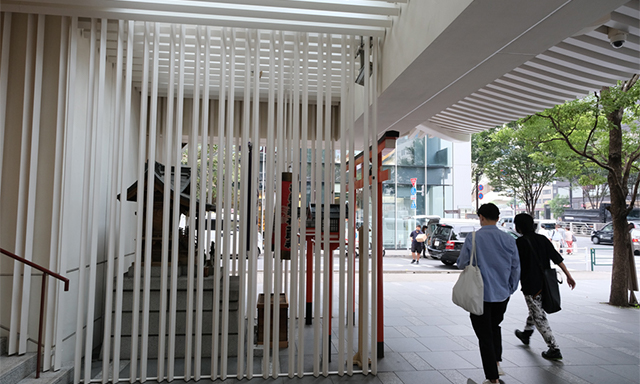
- Ogikubo
- It could easily be missed, but it is indeed right in front of the escalator.
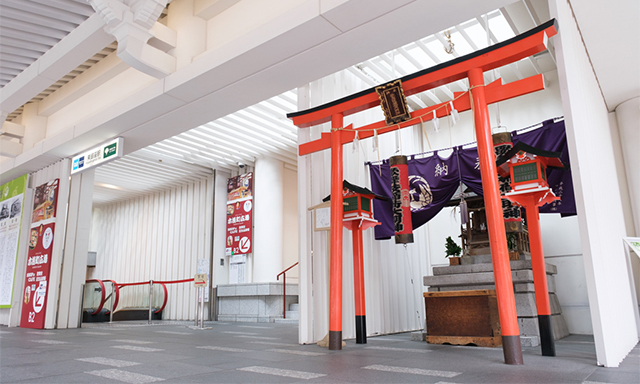
- Uino
- Even now, prayers are given on important days, including the first and last day of a performance. Some earnest actors come to pray on a daily basis.
- Ogikubo
- I notice that quite a few people make a brief visit as they pass by, putting their palms together towards the shrine.
- Uino
- By the way, why was the Kabukiza built in Ginza?
- Ogikubo
- I conducted some research a while ago, wondering why the Kabukiza was built in Ginza, because it seems isolated from its surroundings. This area was called Kobikicho when Edo Palace was under construction. Then in 1644, the Yamamura-za was launched and several playhouses were built. This area is known as one of the origins of Edo Kabuki. It is referred to as “Kobikichô Shibai (Kobikicho Playhouse)” on the Edo Meisho Zué .
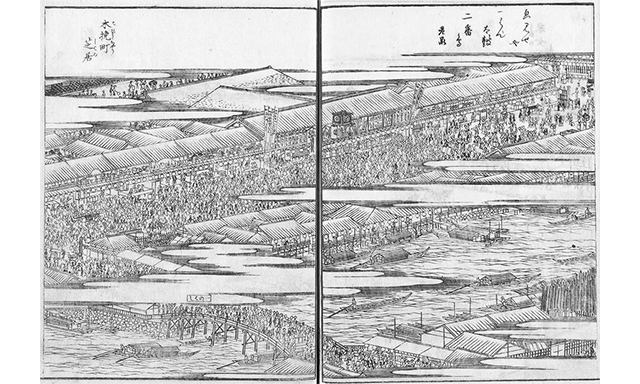
The area is full of playhouses.
- Uino
- This must be Sanjikkenn-hori. I guess kabuki has always been performed in this area.
- Ogikubo
- It would seem so. However, when you look at the Edo Kirié-zu from the end of the Edo period, there are no playhouses to be found in this area.
- Uino
- What happened?
- Ogikubo
- When the bakufu came to face financial difficulties, luxuries were prohibited under the Tenpo Reforms and playhouses were moved to Sarugakicho in Asakusa. Edo Kirié-zu was compiled after the Reforms; and therefore, if you look at the map of Asakusa, you will find many playhouses.
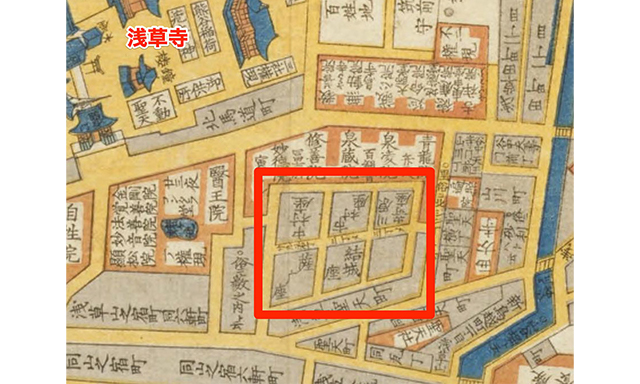
Playhouses, such as Nakamura-za, Ichimura-za and Kawaharazaki-za can be found in the area marked in red.
- Uino
- I recall that Heisei Nakamura-za opened in that area because its history was rooted there. What happened to Kobikicho?
- Ogikubo
- It seems the area once became deserted. In Meiji 22 (1889), the Kabukiza Theatre was built with the aim of creating the largest theater in Japan. Since then, it has been reconstructed several times, and the current Kabukiza is in its fifth reincarnation.
- Uino
- Do you recognize this ofuda (prayer amulet)?
- Ogikubo
- A question out of the blue… It looks like a fine wooden ofuda (talisman).
- Uino
- This ofuda was made by charging a wood plank from the stage with the spirit of the deity.
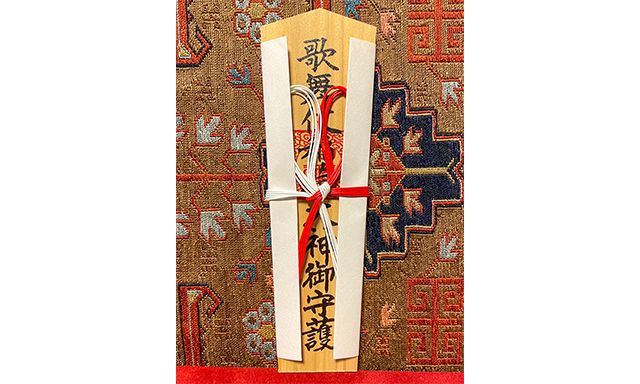
- Ogikubo
- From the stage of the Kabukiza!
- Uino
- With the spread of COVID-19, the theater was closed for a while in 2020. They wanted to offer kabuki fans who had looked forward to the performances something to enjoy while they awaited the theater’s reopening. That is how they came up with having wood planks from the old stage floor charged with the spirit of the Inari deity. Wouldn’t it be exciting to have a part of the stage that your favorite actor performed on? The fact that it is ofuda from the Inari Shrine makes it even more special!
- Ogikubo
- That is certainly something that a kabuki fan would want.
- Uino
- That is what I thought. We can still obtain one at the reception at Kobikicho Hiroba on the basement floor and at the Rakuza souvenir shop on the fifth floor of the Kabukiza. Now, let us have a look inside the Kabukiza.
- Ogikubo
- Will we be allowed in without tickets?
- Uino
- Kobikicho Hiroba and the Kabukiza Gallery on the fifth floor are open to the public.
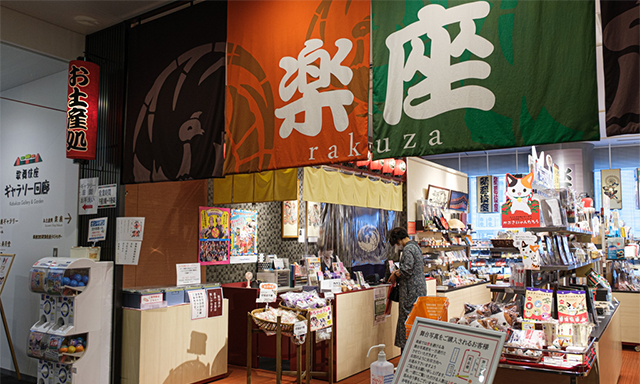
- Ogikubo
- They sell photos of performances, too. This is a great spot. The rooftop garden looks nice too. It interestingly seems to connect the roof tiles of the Kabukiza with the buildings behind it.
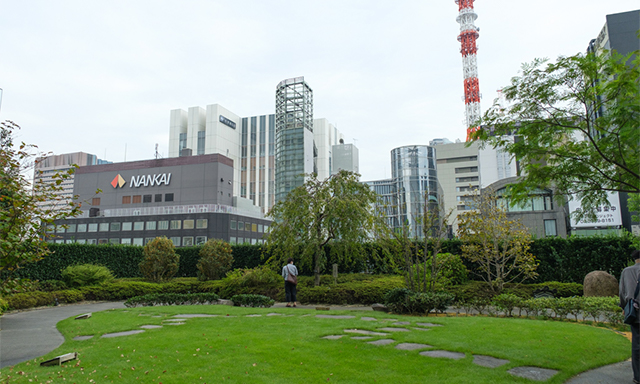
- Uino
- The staircase that takes you from the garden to the fourth floor is also interesting. It is called the Goemon Stairs, named after “Sanmon Gosan no Kiri (The Golden Gate and the Paulownia Crest)” a kabuki act. It reminds one of Ishikawa Goemon’s famous lines: “Zekkeikana zekkeikana (What a view! What a view!)” It is a popular photo spot.
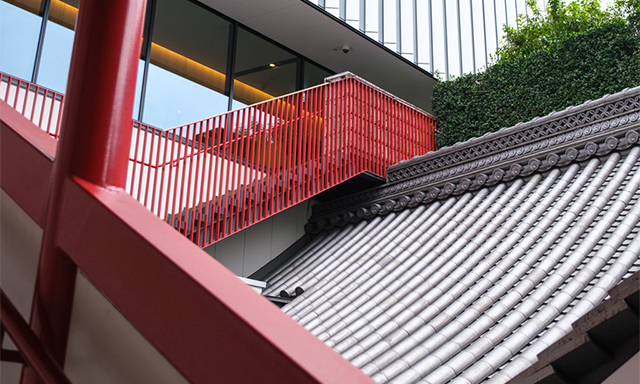
- Ogikubo
- At the bottom of the stairs, there is a scale model of the past Kabukiza buildings. I didn’t know that the first building constructed in Meiji 22 (1891) was a Western-style building. It does look very Meiji-like.
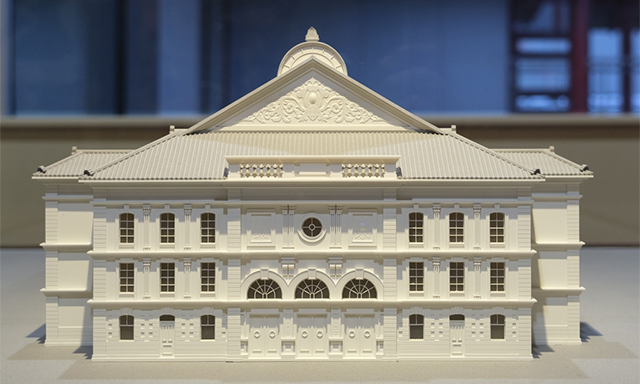
- Ogikubo
- The fourth building with which we are familiar is painted in detail and looks very real.
- Uino
- Ogikubo-san, look here. On the right-hand side of the building, you can find the Inari Shrine.
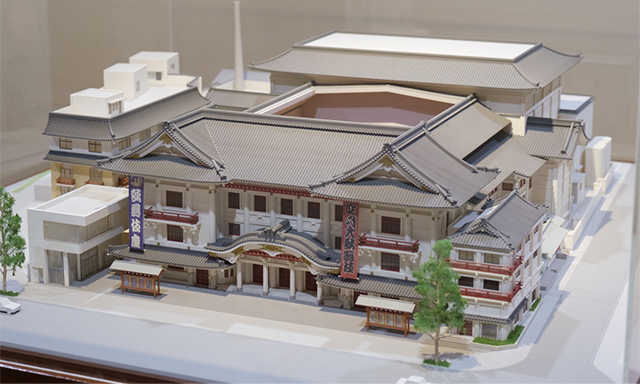
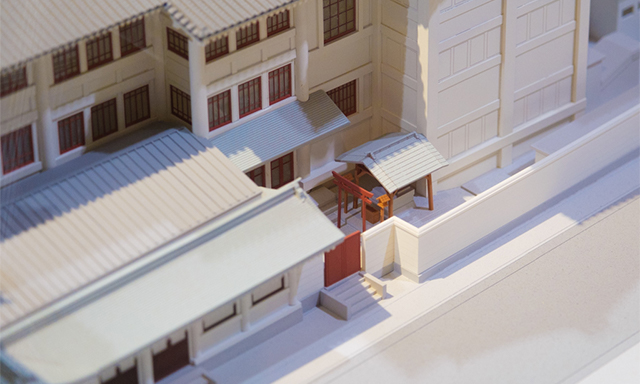
- Ogikubo
- I see. This is where the Kabuki Inanari stood! How exciting to see the small details replicated.
- Uino
- I encourage you to see a Kabuki performance. I am sure that if you saw a Sewamono (contemporary setting play), you would enjoy slipping into the Edo scene.
- Ogikubo
- Seeing a Kabuki performance after 20 years sounds good. Please advise which acts I would enjoy.
All List
- 2020.05.01 Visit Ginza’s Inari Shrines Vol.2 Asahi Inari Shrine
- 2020.08.01 Vol.3 Exploring Ginza in the Edo Period on an old map
- 2020.11.01 Visit Ginza’s Inari Shrines Vol. 4 Kakugo Inari Shrine
- 2021.02.01 Visit Ginza’s Inari Shrines Vol. 5 Azuma Inari
- 2021.05.01 Visit Ginza’s Inari Shrines Vol.6 Kabuki Inari
- 2021.08.01 Visit Ginza’s Inari Shrines Vol.7 Ginza Inari in Ginza 2-chome
- 2021.11.01 Visiting Ginza’s Shrines Vol. 8 Kumagai Inari Shrine
- 2022.02.01 Visit Ginza Shrines Vol. 9 Saiwai Inari Shrine
- 2022.05.01 Visit Ginza’s Shrine Vol. 10 Mimeguri Shrine and Shusse Jizoson on the roof of Mitsukoshi Department Store
- 2022.08.01 Visit Ginza’s Shrines Vol. 11 Komparu Inari
- 2022.11.01 Visit Ginza’s Inari Shrines Vol.12 Mankin Ryujin Seiko Inari Shrine
- 2023.02.01 Visit Ginza’s Shrines Vol.13 Hachikan Shrine
- 2023.05.01 Visit Ginza’s Inari Shrines Vol.14 Hoju Inari Shrine
- 2023.08.01 Visit Ginza’ Inari Shrines Vol. 15 Ryuko Fudo-son
- 2023.11.01 Visit Ginza’s Shrines Vol. 16 Hodo Inari Shrine
- 2024.02.01 Visit Ginza’s Shrines Vol. 17 Toyoiwa Inari Shrine
- 2024.05.01 Visit Ginza’s Inari Shrines Vol. 18 Yasuhira Shrine
- 2024.08.01 Visit Ginza’s Inari Shrines: Final Edition








